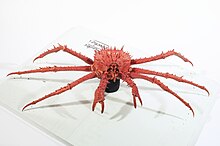Neolithodes brodiei, also known as Brodie's king crab,[3] is a species of king crab which is native to New Zealand and its adjacent waters.[4] It lives at a depth of 500–1,240 metres (1,640–4,070 ft) but is typically found within a range of 950–1,150 metres (3,120–3,770 ft).[4] It is the most widespread and common lithodid in New Zealand waters,[4] and the New Zealand Department of Conservation has classified it as "Not Threatened" in 2013 and 2023.[5][1]
| Neolithodes brodiei | |
|---|---|

| |
| Scientific classification | |
| Domain: | Eukaryota |
| Kingdom: | Animalia |
| Phylum: | Arthropoda |
| Class: | Malacostraca |
| Order: | Decapoda |
| Suborder: | Pleocyemata |
| Infraorder: | Anomura |
| Family: | Lithodidae |
| Genus: | Neolithodes |
| Species: | N. brodiei
|
| Binomial name | |
| Neolithodes brodiei | |
Description
editNeolithodes brodiei is deep-red in colour and has numerous small spinules on its pereiopods and carapace as well as major spines scattered throughout its dorsal surface.[4] They have a pyriform carapace having been measured as large as 188 mm (7.4 in) in length[a] and 161.6 mm (6.36 in) in width, making them the second-largest lithodids known from New Zealand after Lithodes aotearoa.[4]
Distribution
editNeolithodes brodiei lacks a known presence beyond depths of about 1,200 m (3,900 ft), meaning its distribution is likely bounded by the extent of the continental slope around New Zealand.[4] It has allegedly been found in the Haima cold seeps in the northwestern South China Sea at depths of approximately 1,300–1,400 metres (4,300–4,600 ft), but it may only occasionally visit the ecosystem.[6]
In 2001, a paper was published in Zoosystema which claimed to have found a specimen of N. brodiei in Vanuatu;[7] however, this was later determined to be a yet-undescribed species.[4] Likewise, a 2005 paper in Polar Biology claimed to have found four specimens off the Balleny Islands in the Southern Ocean,[8] but these were misidentified and were later determined to be a new species called Neolithodes yaldwyni.[4] It was also thought to occur in the Tasman Sea, but this was also determined to be a new species called Neolithodes flindersi.[4]
Etymology
edit"Neolithodes" is derived from Greek and Latin and means "new stone-crab",[9] while "brodiei" takes its namesake from James William Brodie, then-Director of the New Zealand Oceanographic Institute.[2]
See also
editNotes
editReferences
edit- ^ a b Funnell, Greig; et al. (January 2023). Todd, Amanda (ed.). Conservation status of indigenous marine invertebrates in Aotearoa New Zealand, 2021 (PDF) (Report). New Zealand Department of Conservation. p. 36. ISBN 978-1-99-118365-1. Retrieved 19 March 2023.
- ^ a b Yaldwyn, John Cameron; Dawson, Elliot Watson (June 1970). "Diagnosis of a New Species of Neolithodes (Crustacea: Anomura: Lithodidae) from New Zealand (Note)" (PDF). New Zealand Journal of Marine and Freshwater Research. 4 (2): 227–228. Retrieved 16 May 2020 – via the Natural History Museum of Los Angeles County.
- ^ "Brodie's king crab (NEB)". Fisheries New Zealand. Retrieved 2024-05-13.
- ^ a b c d e f g h i j Ahyong, Shane T. (2010). The Marine Fauna of New Zealand: King Crabs of New Zealand, Australia, and the Ross Sea (Crustacea: Decapoda: Lithodidae) (PDF). NIWA Biodiversity Memoirs. Vol. 123. National Institute of Water and Atmospheric Research. pp. 74–83. ISBN 978-0478232851. LCCN 2010497356. Archived (PDF) from the original on 15 February 2020.
- ^ Freeman, Debbie; et al. (December 2014). Conservation status of New Zealand marine invertebrates, 2013 (PDF) (Report). New Zealand Threat Classification Series. Vol. 9. Department of Conservation. p. 13. ISBN 978-0478150322. Archived (PDF) from the original on 9 April 2018. Retrieved 15 May 2020.
- ^ Ke, Zhixin; Li, Ruofei; Chen, Yu; Chen, Danting; Chen, Zhiyun; Xiping, Lian; Tan, Yehui (June 2022). "A preliminary study of macrofaunal communities and their carbon and nitrogen stable isotopes in the Haima cold seeps, South China Sea". Deep Sea Research Part I: Oceanographic Research Papers. 184: 103774. Bibcode:2022DSRI..18403774K. doi:10.1016/j.dsr.2022.103774.
- ^ Macpherson, Enrique (2001). "New species and new records of lithodid crabs (Crustacea, Decapoda) from the southwestern and central Pacific Ocean" (PDF). Zoosystema. 23 (4): 797–805. Archived (PDF) from the original on 13 August 2017 – via the Natural History Museum of Los Angeles County.
- ^ Thatje, Sven; Lörz, Anne-Nina (10 November 2004). "First record of lithodid crabs from Antarctic waters off the Balleny Islands" (PDF). Polar Biology. 28: 334–337. doi:10.1007/s00300-004-0686-1. Archived (PDF) from the original on 18 November 2017.
- ^ Emmerson, W. D. (July 2016). A Guide to, and Checklist for, the Decapoda of Namibia, South Africa and Mozambique. Vol. 2. Cambridge Scholars Publishing. p. 93. ISBN 978-1-4438-9097-7.
External links
edit- Media related to Neolithodes brodiei at Wikimedia Commons
- Data related to Neolithodes brodiei at Wikispecies
